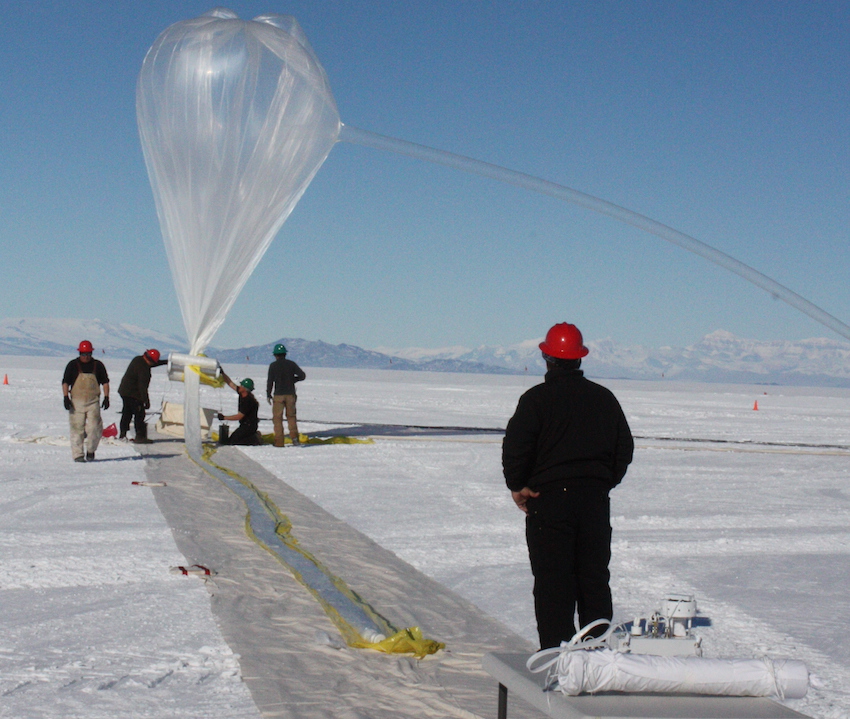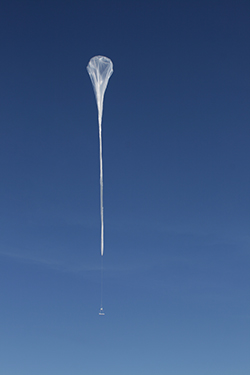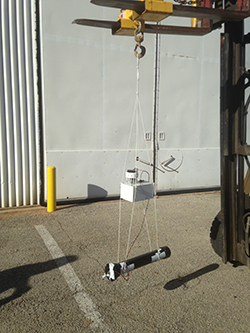BBQ lighter hovering above South Pole may help pinpoint mystery source of cosmic energy

LAWRENCE — Soaring some 23 miles over the South Pole, a University of Kansas experiment slung from a high-altitude weather balloon is calculating how the surface of Antarctica reflects radio signals caused by ultra-high-energy cosmic rays.
 The Hi-Cal (High-Altitude Calibration) experiment loops around the South Pole, trailing hundreds of miles behind yet another cluster of instruments strapped to a much larger balloon, called ANITA (for Antarctic Impulsive Transient Antenna, and funded by NASA since 2003).The ultimate experimental goal is to measure ultra-high energy neutrinos and ultra-high energy cosmic rays that interact in the Antarctic ice, or with the Earth’s atmosphere, creating radio waves.
The Hi-Cal (High-Altitude Calibration) experiment loops around the South Pole, trailing hundreds of miles behind yet another cluster of instruments strapped to a much larger balloon, called ANITA (for Antarctic Impulsive Transient Antenna, and funded by NASA since 2003).The ultimate experimental goal is to measure ultra-high energy neutrinos and ultra-high energy cosmic rays that interact in the Antarctic ice, or with the Earth’s atmosphere, creating radio waves.
To understand the purpose of Hi-Cal, first grasping the research mission of ANITA is key.
“The ANITA experiment is to detect ultra-high energy cosmic rays, and these are detected by virtue of the radio frequency radiation produced when a cosmic ray hits a terrestrial molecule — that creates spray of debris including particles and radio frequency radiation,” said David Besson, professor of physics & astronomy at KU, who is leading the Hi-Cal team.
Besson said the down-coming cosmic rays generate radio frequencies detected by ANITA primarily as surface reflections, bouncing back up from the surface of Antarctica.
“To understand the properties from the radio frequencies ANITA collects, you have to understand the surface reflectivity,” Besson said.
Here is where the Hi-Cal experiment operated by KU comes in to play.
“Hi-Cal is a companion experiment that flies anywhere from 125 to 620 miles behind the main payload and sends out a ping,” Besson said. “That radio-frequency ping, which has a duration of 10 to 20 nanoseconds, is detected by ANITA coming directly from the Hi-Cal transmitter as well as from surface reflection from Antarctica. By looking at the ratio of the two signals you can infer the surface properties of Antarctic snow.”
 While the lead ANITA balloon is laden with thousands of dollars of high-tech gadgetry, the follow-on Hi-Cal balloon uses a piezoelectric lighter anyone could buy at a hardware store as its pinging device.
While the lead ANITA balloon is laden with thousands of dollars of high-tech gadgetry, the follow-on Hi-Cal balloon uses a piezoelectric lighter anyone could buy at a hardware store as its pinging device.
“The heart of the Hi-Cal project is a $10 barbeque lighter,” Besson said. “It’s a very clever idea a couple of graduate students showed could work. When we turned it on in the first mission three years ago, ANITA immediately registered signals from Hi-Cal 500 miles away. The advantage of Antarctica is that it’s so radio quiet, this is possible — here in Lawrence, Kansas, it would be challenging with so much radio noise.”
Unlike lighters with a flint mechanism, piezoelectric lighters work when compressed mechanically and suddenly released.
“The stored mechanical energy, if you think of it as a spring, shows up as a very high voltage,” Besson said. “With this piezoelectric lighter, we were able to generate voltages that were as much as $20,000 signal generators you’d have to custom order. The downside is it requires fine-tuning to optimize.”
Funded by $230,000 of NASA funding about three years ago, the Hi-Cal balloon with its barbeque-lighter ping have flown three experimental missions in a quest to better grasp Antarctica’s reflectivity to radio frequencies. Key researchers at KU working on the experiment include Steven Prohira, Sasha Novikov, Jessica Stockham and Mark Stockham.
“We have one launch every couple of years,” Besson said. “The balloon goes up and circles around. In Antarctica, there’s the circumpolar vortex. If you launch a balloon, it flies in a circle around the pole until the wind starts to carry it away from the continent and toward the ocean. When that happens, you send it a signal to drop the ANITA payload. This most recent payload was dropped last January, and right now there’s a recovery team including two members from KU that’s retrieving the experimental hardware. They fly to the location on Twin Otter aircraft and hunt for it.”
The smaller Hi-Cal payload is not recovered. Besson said the last flight of Hi-Cal lasted for about 10 days. Both experiments will fly in tandem again in 2020.
“We’re trying to calibrate Antarctica,” Besson said. “If you can understand the reflectivity of Antarctica, you could make an accurate measurement of the energy spectrum for each cosmic ray in its surface reflection. You need this measurement to unfold effects of surface reflectivity.”
According to the KU researcher, as the scientists behind both Hi-Cal and ANITA amass more data, they hope to be able to detect the source the ultra-high-energy cosmic rays.
“This is one of the big holy grails of contemporary cosmic ray physics, called particle astrophysics,” he said. “The holy grail is to identify a point in the sky that’s producing very high-energy cosmic rays, but people have had limited success. There is some evidence from other experiments that a type of radio-loud galaxy called a blazar may harbor a supermassive black hole at its center. Another source could be a gamma-ray burst. We hope this work can help narrow down the source — you need to know surface reflectivity characteristics to get that picture.”
Besson suggested that recently ANITA may have landed upon an even deeper mystery.
“They’ve detected a class of events which do not seem to fit either cosmic-ray proton or the cosmic-ray neutrino process — their source is definitely a puzzle,” he said. “ANITA is the only experiment that has detected this class of events. There was an announcement by ANITA and a couple of follow-up theory papers recently.”
Top photo: Launching the Hi-Cal experiment. Top right: The Hi-Cal soars above Antarctica to circle the South Pole trailing ANITA. Bottom right: The Hi-Cal payload has at its heart a piezoelectric lighter. Images courtesy of Steven Prohira and Alexander Novikov.